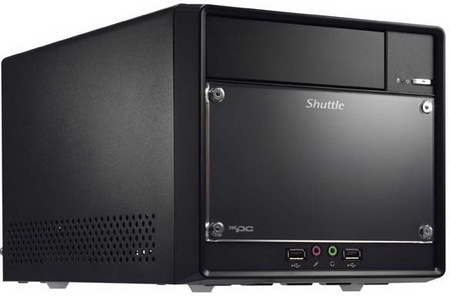
|
The market of entry-level barebone systems has been recently replenished with a new elaboration from Shuttle. Codenamed SH81R4, this model is housed in an aluminum case with an acrylic frontal panel, featuring 325x215x190 mm dimensions. The greenhorn provides for a strong expandability options to satisfy the needs of various applications. Besides, it comes equipped with a 300 W power supply unit, peculiar by 80 Plus Bronze certificate.
The heart of the barebone is Intel H81 Express chipset that supports CPUs for LGA1150 socket and the maximal TDP level of 95 W (Haswell Core i3/i5/i7, Celeron, Pentium). Memory subsystem welcomes DDR3 modules of up to 16 GB capacity (dual-channel operational mode). Graphics is already integrated into the CPU. Audio facilities are represented by Realtek ALC662 controller that supports 5.1-channel HD sounding, whereas network functioning is due to Realtek RTL 8111E controller with Wake-on-LAN options.
To continue, storage is organized around one 5.25-inch bay and two 3.5-inch bays. Herein, drives are connected to the system via SATA II 3 Gb/sec and SATA III 6 Gb/sec interfaces. Connectivity is the other peculiar feature of SH81R4. The model boasts a range of onboard connectors (AUX-in header, RS232 header, GPIO header, LPC header, 5-pin USB header, 4-pin fan, 3-pin fan, ATX main power connectors), frontal (USB 2.0, 2x audio jacks, HDD/ODD LED backlight) and rear (2x USB 3.0, 6x USB 2.0, LAN, CMOS, Line in/out, HDMI supporting 4K displays, DVI-I) I/O interfaces.
Internal layout offers four expansion slots, including PCIe x16, PCIe x1, mini-PCIe (full size), and mini-PCIe (half size). Heat dissipation process is relied on a heatspreader and heatpipes which use I.C.E. technology (Integrated Cooling Engine). It embraces convection process for a more efficient CPU cooling. A low-profile 92 mm fan (SilentX) creates a powerful airflow that practically freezes all hot components.
Shuttle SH81R4 can work as with Windows so with Linux OS platforms. It also allows for individual system modification by replacing native mainboard by a more advanced mini-ITX solution. What is more, this barebone appears to be rather power-efficient thanks to the implementation of Power-on by RTC function; it enables setting ‘Power on’ and ‘Power off’ times via BIOS interface. |

